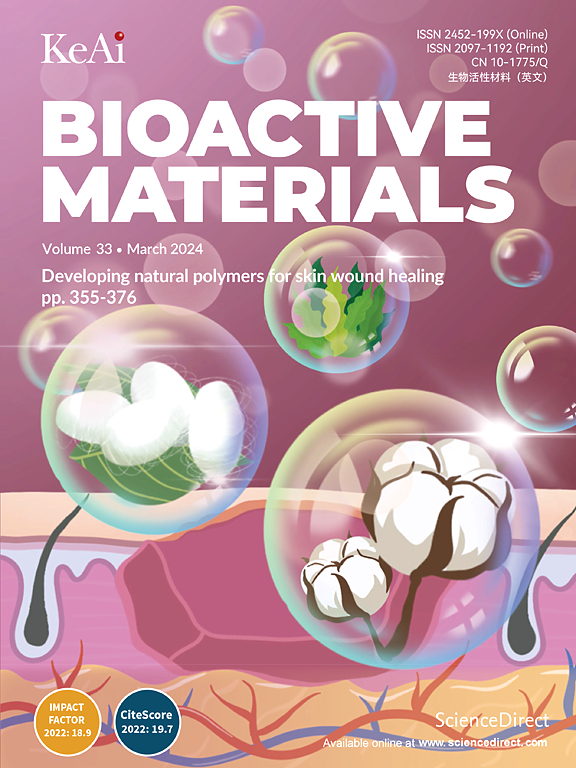具有NO/O2释放的双层微针通过神经发生、血管生成和免疫调节促进糖尿病伤口愈合。
IF 18
1区 医学
Q1 ENGINEERING, BIOMEDICAL
引用次数: 0
摘要
糖尿病创面存在多种功能损伤,包括神经血管失调、氧化失衡和免疫功能障碍,使得创面愈合尤其具有挑战性,而传统的治疗策略未能有效解决这些复杂的问题。在此,我们提出了一种利用双层微针通过调节神经血管耦合和免疫功能来输送治疗气体的策略,用于糖尿病伤口治疗。微针可以响应糖尿病微环境中的活性氧(ROS),随后产生氧气(O2)和一氧化氮(NO)。这些气体全面促进神经血管再生,降低氧化应激水平,减轻炎症。体内研究表明,微针可以通过调节神经血管再生和炎症过程来加速糖尿病伤口愈合。转录组学分析进一步证实了相关有利信号通路的参与。其潜在机制包括激活PI3K-AKT-mTOR通路促进自噬,最终加速愈合过程。因此,我们的多功能双层微针为治疗糖尿病伤口提供了一种有效的策略。本文章由计算机程序翻译,如有差异,请以英文原文为准。
Dual-layer microneedles with NO/O2 releasing for diabetic wound healing via neurogenesis, angiogenesis, and immune modulation
Diabetic wounds present multiple functional impairments, including neurovascular dysregulation, oxidative imbalance, and immune dysfunction, making wound healing particularly challenging, while traditional therapeutical strategies fail to address these complex issues effectively. Herein, we propose a strategy utilizing dual-layer microneedles to deliver therapeutic gases by modulating neurovascular coupling and immune functions for diabetic wound treatment. The microneedle can respond to reactive oxygen species (ROS) in the diabetic microenvironment and subsequently generate oxygen (O2) and nitric oxide (NO). These gases comprehensively promote neuro-vascular regeneration, reduce oxidative stress levels, and attenuate inflammation. In vivo studies demonstrate that the microneedle can accelerate diabetic wound healing by modulating neurovascular regeneration and inflammatory processes. Transcriptomic analyses further validate the involvement of related advantageous signaling pathways. The potential mechanism involves the activation of the PI3K-AKT-mTOR pathway to facilitate autophagy, ultimately accelerating the healing process. Thus, our multifunctional dual-layer microneedles provide an effective strategy for treating diabetic wounds.
求助全文
通过发布文献求助,成功后即可免费获取论文全文。
去求助
来源期刊

Bioactive Materials
Biochemistry, Genetics and Molecular Biology-Biotechnology
CiteScore
28.00
自引率
6.30%
发文量
436
审稿时长
20 days
期刊介绍:
Bioactive Materials is a peer-reviewed research publication that focuses on advancements in bioactive materials. The journal accepts research papers, reviews, and rapid communications in the field of next-generation biomaterials that interact with cells, tissues, and organs in various living organisms.
The primary goal of Bioactive Materials is to promote the science and engineering of biomaterials that exhibit adaptiveness to the biological environment. These materials are specifically designed to stimulate or direct appropriate cell and tissue responses or regulate interactions with microorganisms.
The journal covers a wide range of bioactive materials, including those that are engineered or designed in terms of their physical form (e.g. particulate, fiber), topology (e.g. porosity, surface roughness), or dimensions (ranging from macro to nano-scales). Contributions are sought from the following categories of bioactive materials:
Bioactive metals and alloys
Bioactive inorganics: ceramics, glasses, and carbon-based materials
Bioactive polymers and gels
Bioactive materials derived from natural sources
Bioactive composites
These materials find applications in human and veterinary medicine, such as implants, tissue engineering scaffolds, cell/drug/gene carriers, as well as imaging and sensing devices.
 求助内容:
求助内容: 应助结果提醒方式:
应助结果提醒方式:


